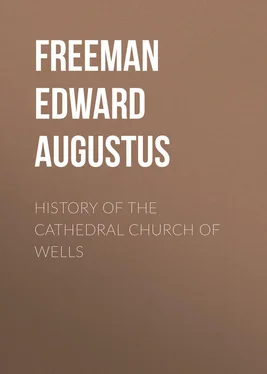Edward Freeman - History of the Cathedral Church of Wells
Здесь есть возможность читать онлайн «Edward Freeman - History of the Cathedral Church of Wells» — ознакомительный отрывок электронной книги совершенно бесплатно, а после прочтения отрывка купить полную версию. В некоторых случаях можно слушать аудио, скачать через торрент в формате fb2 и присутствует краткое содержание. Жанр: foreign_antique, foreign_prose, на английском языке. Описание произведения, (предисловие) а так же отзывы посетителей доступны на портале библиотеки ЛибКат.
- Название:History of the Cathedral Church of Wells
- Автор:
- Жанр:
- Год:неизвестен
- ISBN:нет данных
- Рейтинг книги:4 / 5. Голосов: 1
-
Избранное:Добавить в избранное
- Отзывы:
-
Ваша оценка:
- 80
- 1
- 2
- 3
- 4
- 5
History of the Cathedral Church of Wells: краткое содержание, описание и аннотация
Предлагаем к чтению аннотацию, описание, краткое содержание или предисловие (зависит от того, что написал сам автор книги «History of the Cathedral Church of Wells»). Если вы не нашли необходимую информацию о книге — напишите в комментариях, мы постараемся отыскать её.
History of the Cathedral Church of Wells — читать онлайн ознакомительный отрывок
Ниже представлен текст книги, разбитый по страницам. Система сохранения места последней прочитанной страницы, позволяет с удобством читать онлайн бесплатно книгу «History of the Cathedral Church of Wells», без необходимости каждый раз заново искать на чём Вы остановились. Поставьте закладку, и сможете в любой момент перейти на страницу, на которой закончили чтение.
Интервал:
Закладка:
For my first portion then this evening, I purpose to take as my subject the early days of the church of Saint Andrew, from the first time that its name is heard of in history or record to the time when both the material fabric and the ecclesiastical foundation assumed something like their present form. And as this subject will lead us into somewhat obscure times, and into many matters which people in general are far from accurately understanding, I hope that those among my hearers to whom all that I have to say is familiar will forgive me if I deal with some matters in a somewhat elementary way. I have spoken of Saint Andrew's church in Wells as a cathedral church, as a cathedral church which has always been served by secular canons; I have spoken of an opposition between the regular and the secular clergy. To some of my hearers all these terms carry their meaning at once. To others I am afraid that they may not suggest any very definite idea. But without a definite idea of them neither the general history of England nor the local history of Wells can be clearly understood. Let then my better informed hearers bear with me if I go somewhat into the A B C of the matter.
To begin then with the beginning, what do we mean when we call the larger of the two ancient churches in this city, the Cathedral ? What is the meaning of the word? Some people seem to think it means simply a bigger church than usual – I have heard a vast number of churches in other places called cathedrals which have no right to the name. Sometimes people seem to think that it means a church which has a Dean and Chapter or a special body of clergy of some kind, or a church where there are prayers every day, or a church where the prayers are chanted and not merely read. Nay, some people seem to think that a cathedral is not a church at all; I have heard it said that a cathedral was not a church, but that it had a church inside it. And I do not wonder at people thinking so when they go into a cathedral church, and see the greater part standing empty indeed and swept, but never garnished. I was once in a large parish church, that of Grosmont in Monmouthshire, where the man who let me in told me very proudly: "Our church is like a cathedral." What he meant by the church being like a cathedral was that the whole congregation was rammed, jammed, crammed into the choir, while the nave stood empty and useless. Again it is not at all uncommon to hear people talk of "cathedrals and churches," as if they were two different sorts of things. And people seem also to think that some particular sort of worship is right in a cathedral, which is not right in other places. When there is a good deal of singing and organ-playing in divine service, they call it "cathedral service," as if singing and organ-playing were something specially belonging to a cathedral more than to other places.
Now all these latter notions are simply mistakes. And those with which I began are mistakes too, though in a somewhat different way. A cathedral is simply a church, one particular sort of church, and, instead of being a thing to be proud of, it is a thing to be ashamed of if the nave of any church stands empty and useless. What is called "cathedral service" is simply divine service done in the best and most solemn way, a way which other churches may not always be able to follow in everything, but which they should try to follow as nearly as they can. On the other hand, it is very right that a cathedral church should be larger and finer than other churches, that it should have a larger body of clergy belonging to it, and that they should perform divine service in such a way as to be a light and an example to other churches. Still none of these things lies at the root of the matter; it is none of these things which makes the difference between a cathedral and another church. That difference is that it contains the throne or official seat of the Bishop. In Greek and Latin that seat is called cathedra , – a word which in English is cut short into chair – and the church which contains it is called ecclesia cathedralis , the cathedral church . Cathedral in short is an adjective and not a substantive, and its use as a substantive is always rather awkward and slovenly. Certain churches, namely those which contain the throne of a Bishop, are cathedral churches, as churches which do not contain the throne of a Bishop, but which have a Chapter or College of clergy, are collegiate churches, while the great mass of churches are simply parochial churches, churches designed for the use of a single parish, and with only a single parish priest.
The essence then of the cathedral church is its being, beyond all other churches, the church of the Bishop. It is the church which contains his official seat, and it is by taking possession of that official seat that the Bishop, as we shall presently see when our newly chosen Bishop comes among us, takes possession of his Bishoprick. 3 3 This Lecture was given in the time between the election and installation of the present Bishop, Lord Arthur Hervey.
From that seat the church, and the city in which it stands, is called the Bishop's See . And from that see the Bishop takes his title. Thus we call this city of Wells the see of a Bishop, the Bishop of Bath and Wells. The Bishop is called Bishop of Bath as well as of Wells, because this diocese, unlike most others, contained two cathedral churches. The Bishop had his throne in the church of Saint Peter at Bath as well as in the church of Saint Andrew at Wells. But since the time of Henry the Eighth the church of Bath has not been reckoned as a cathedral church, and the Bishop has been enthroned in the church of Wells only.
Now you may ask how it is that, while, of all the churches of the diocese, the cathedral church is pre-eminently the Bishop's church, the church which is specially his own, and whence he takes his title, it is precisely in the cathedral church that he has less authority than in any other church, that the whole management of the cathedral church seems to have passed away from the Bishop into the hands of the Dean and Chapter. The independence of the Dean and Chapter, when it is carried so far as it now is, is undoubtedly an abuse and an anomaly, and how it came about I shall show as I go on. You may also ask how it happened that the see of the Bishop of this diocese should have been placed at Wells rather than anywhere else. For it was at Wells that it was placed first of all, and it was not till nearly two hundred years after the foundation of the Bishoprick that Bath became a cathedral church.
To see how this happened we must go back to the days of the first preaching of the Gospel to Englishmen. In those parts of Western Europe which first became Christian, in Italy, for instance, and Gaul and Spain, the cities were at that time almost everything the open country was of very little account. The Gospel was therefore first preached to the people of the cities, and the cities had become almost wholly Christian at a time when the people of the country were still mainly heathens. Hence the word pagan – in Latin paganus – which at first meant only a countryman as opposed to a townsman, came to mean a heathen or worshipper of false gods. Now in this state of things the Bishop was pre-eminently the Bishop of the city; the city was his home, and the home of his original flock; it was only gradually that he came to have much to do with the people beyond the city, and, when he did so, the limits of his diocese were fixed by the limits of the civil jurisdiction of the city of which he was Bishop. In England, and indeed in the British Islands generally, the state of things was very different. The country was divided among many princes; there were but few large towns, and those that there were exercised no authority over the people of the country round them. In England therefore at first there commonly was a Bishop in each Kingdom; he fixed his throne, his bishopstool as it was called, in some particular church in his diocese, which thus became his special home and cathedral church; but he was not Bishop of the city in the same special sense in which an Italian or even a Gaulish Bishop was Bishop of the city. In fact in many of the English dioceses the Bishop did not even take his title from the city where his cathedral church stood, but was called from the country at large, or rather from the tribe which inhabited it. Thus up to the Norman Conquest the Bishop of this diocese was not called the Bishop of Wells, but the Bishop of the Sumorsætas, the tribe from which Somersetshire takes its name.
Читать дальшеИнтервал:
Закладка:
Похожие книги на «History of the Cathedral Church of Wells»
Представляем Вашему вниманию похожие книги на «History of the Cathedral Church of Wells» списком для выбора. Мы отобрали схожую по названию и смыслу литературу в надежде предоставить читателям больше вариантов отыскать новые, интересные, ещё непрочитанные произведения.
Обсуждение, отзывы о книге «History of the Cathedral Church of Wells» и просто собственные мнения читателей. Оставьте ваши комментарии, напишите, что Вы думаете о произведении, его смысле или главных героях. Укажите что конкретно понравилось, а что нет, и почему Вы так считаете.












